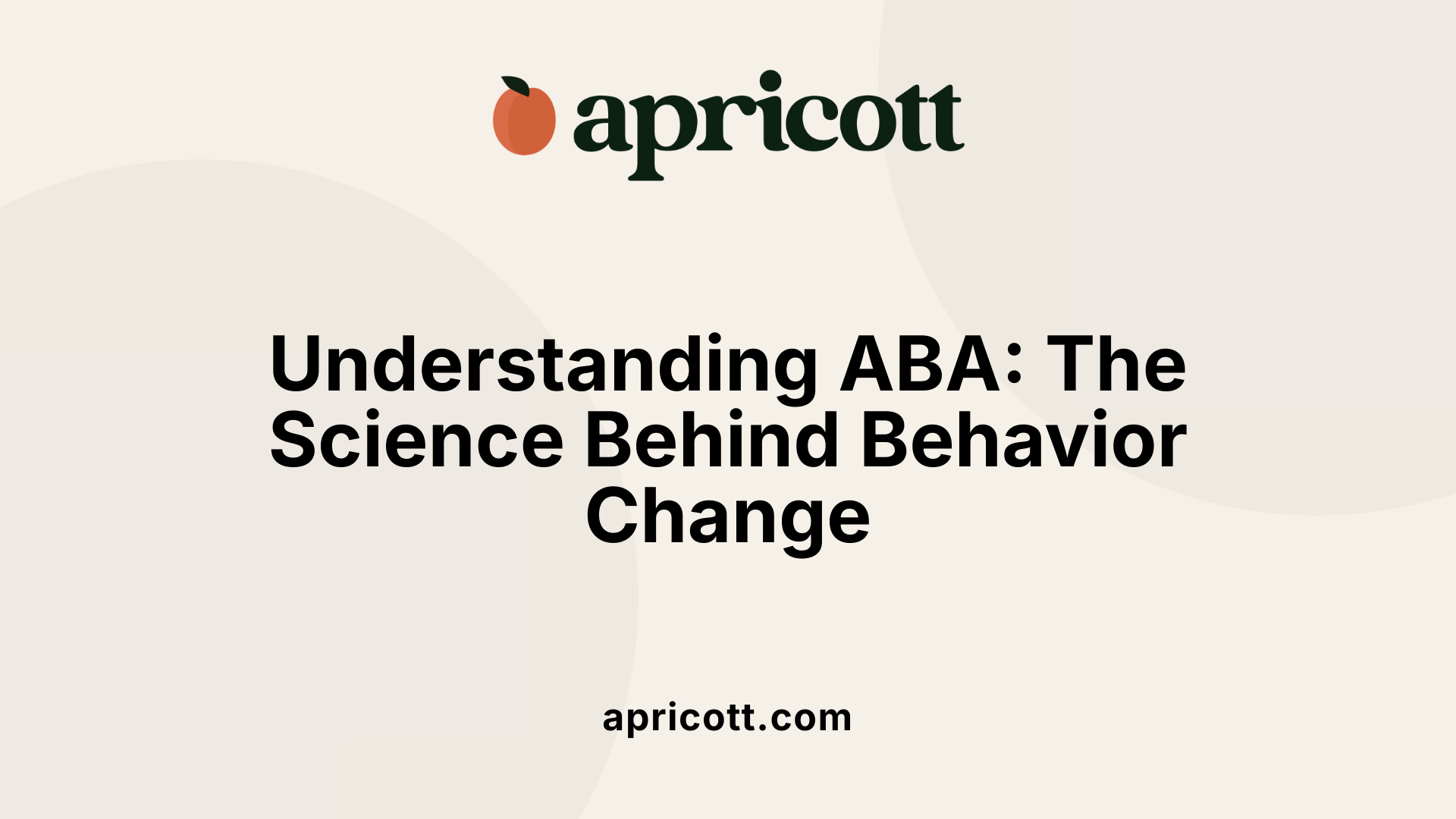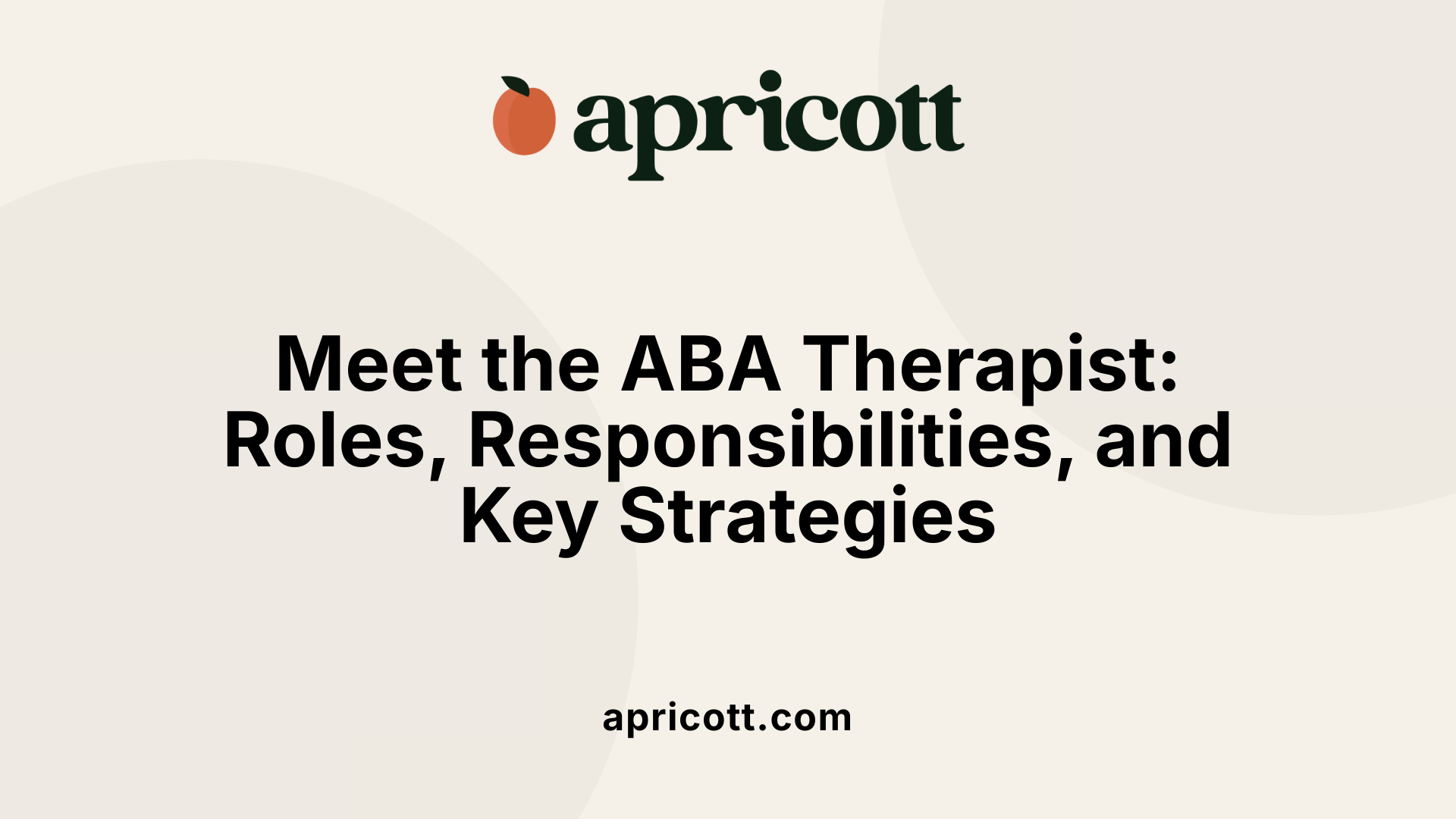August 12, 2025
Unlocking the Role and Impact of ABA Therapists in Autism Care
Applied Behavior Analysis (ABA) therapy stands as a cornerstone intervention for individuals with autism spectrum disorder (ASD). Central to this therapy are ABA therapists, highly trained professionals dedicated to improving the skills and behaviors of their clients. This article explores what an ABA therapist is, their responsibilities, the techniques they employ, their training pathways, and the evolving ethical landscape within which they operate.

Applied Behavior Analysis (ABA) has its roots deeply embedded in the early 20th century fields of behaviorism. Pioneers like John B. Watson and B.F. Skinner played instrumental roles in shaping the scientific understanding of human and animal behavior. Watson, often called the father of behaviorism, emphasized observable behaviors and dismissed introspection. Skinner expanded on these ideas, developing operant conditioning principles based on reinforcement and punishment.
In the 1960s, Ivar Lovaas emerged as a key figure, pioneering the use of ABA specifically for autism. His research demonstrated that intensive behavioral interventions could lead to meaningful improvements in language, social skills, and daily functioning for children with autism. Lovaas’s early work involved highly structured, drill-based methods, such as discrete trial training (DTT), which showed promising results.
Over the subsequent decades, ABA evolved significantly. Initially characterized by rigid, repetitive drills, the approach gradually shifted towards more naturalistic and play-based strategies. These methods focus on engaging children in meaningful activities within their natural environment, reinforcing desired behaviors in real-life contexts.
This transition was also driven by ethical considerations and critiques concerning the use of aversive techniques and overly strict procedures. As the field matured, efforts were made to incorporate family involvement, promote dignity and autonomy, and adapt therapies to meet individual needs.
The professionalization of ABA was marked by the establishment of organizations like the Behavior Analyst Certification Board (BACB) and publications such as the Journal of Applied Behavior Analysis. These advances helped define standards for practice, certification, and research.
Today, ABA remains a dynamic discipline, blending scientific rigor with compassionate, individualized care. It continues to incorporate new research, technology, and ethical frameworks to improve outcomes for those with autism and other developmental disorders.

Applied Behavior Analysis (ABA) therapy is a scientific method rooted in the principles of learning and behavior. Its primary goal is to help individuals develop helpful behaviors and reduce those that are harmful or interfere with learning.
At its core, ABA applies evidence-based techniques like positive reinforcement—where desirable behaviors are rewarded—to encourage learning. It also uses tools such as antecedent-behavior-consequence (ABC) analysis to understand what triggers certain behaviors and what maintains them over time.
The therapy involves detailed assessments called functional behavior assessments, which help therapists identify the reasons behind behaviors. Based on this, customized treatment plans are devised for each individual, considering their unique needs and environment.
A key model in ABA is the ABC framework:
| Component | Description | Purpose |
|---|---|---|
| Antecedent | The triggering event or situation before a behavior | To identify what prompts the behavior |
| Behavior | The observable action or response | The target for change |
| Consequence | The result or outcome following the behavior | To reinforce or discourage behaviors |
By focusing on these elements, ABA practitioners shape behavior systematically, aiming for meaningful, lasting changes.
ABA is characterized by its scientific approach—using data collection and ongoing assessment to refine interventions. This method ensures consistency and effectiveness, allowing for precise adjustments to support each person’s progress.
Though originally designed to support children with autism, ABA’s principles are applied across various domains, including communication development, social skills, and organizational management. Its adaptability makes it a versatile and powerful tool for fostering positive behavior change.

ABA therapy is highly versatile and can be adapted to a variety of environments to best meet individual needs. It is commonly provided in homes, schools, clinics, and community settings.
In home settings, ABA therapists work directly with children or adults within their familiar environment. This approach allows for real-world skill development, such as daily routines, hygiene, and social interactions, in the comfort of the natural environment. Home-based therapy also facilitates family involvement, which is crucial for reinforcement and generalization of skills.
School settings are another common environment where ABA is applied. Here, therapists collaborate with teachers and school staff to implement behavior interventions and skill-building strategies during the school day. This integration helps promote social skills, communication, and academic performance in typical learning environments.
Clinics provide a structured setting for intensive therapy sessions. These settings are ideal for specialized interventions such as discrete trial training, where highly structured, one-on-one instruction occurs. Clinics often house necessary materials and tools for effective implementation of ABA programs.
Community settings include social venues like parks, recreational centers, or neighborhood environments. In these natural contexts, ABA techniques are used to teach social skills, independent living tasks, and community safety skills, helping individuals navigate and succeed in everyday life.
ABA applications span both structured and naturalistic environments. Structured settings are highly organized with clear routines and goals, ideal for discrete trial training and assessment. Naturalistic environments, on the other hand, focus on learning through play and everyday interactions, using methods like Pivotal Response Treatment and the Early Start Denver Model.
This flexibility allows therapists to tailor interventions so that skills learned during therapy transfer successfully to real-world situations, increasing independence and social participation.
ABA is not limited to children. It supports individuals of all ages, from early childhood through adulthood. Young children often engage in early intensive behavioral intervention (EIBI), focusing on foundational skills such as language and social interaction.
For adolescents and adults, ABA can address life skills such as employment, community navigation, and social relationships. It adapts techniques to suit different developmental stages, with goals geared towards greater independence and quality of life.
ABA is often integrated with other healthcare, educational, and community services. Collaborations with speech therapists, occupational therapists, psychologists, and medical professionals ensure a comprehensive approach to support.
This multidisciplinary model improves consistency in interventions and maximizes positive outcomes for individuals with autism and other developmental disorders.
| Setting | Focus Areas | Adaptations | Typical Users |
|---|---|---|---|
| Home | Daily routines, family skills | Family involvement, natural environment focus | Children and adults with autism or developmental needs |
| School | Social skills, communication, academics | Collaboration with teachers, integration into classroom | School-aged children, adolescents |
| Clinic | Intensive skill acquisition, assessment | Structured, specialized tools | Young children, individuals needing intensive support |
| Community | Social participation, independence | Exposure to real-world environments | All ages, targeting community skills |
Understanding the flexibility and broad application of ABA across different environments underscores its role as an essential intervention for enhancing functioning and independence in individuals with developmental challenges.

An ABA therapist plays a vital role in helping individuals, especially children with autism spectrum disorder (ASD), develop essential skills and decrease harmful behaviors through carefully planned interventions.
Their primary task is to analyze and understand the behavioral issues an individual exhibits. Using the principles of applied behavior analysis — based on the science of learning and behavior — they design personalized treatment programs that focus on specific goals such as improving communication, social skills, attention, and daily living abilities.
A major part of their work involves implementing these treatment plans carefully. This includes using techniques like positive reinforcement—praising or rewarding desired behaviors—and systematically removing negative stimuli to foster positive change.
They continually monitor progress by collecting detailed data during sessions. This ongoing assessment allows them to evaluate whether the current strategies are successful or need adjustment. Data collection helps track improvements in skills like language use, social interactions, or reduction of problematic behaviors.
Training and involving families are also crucial responsibilities. ABA therapists educate caregivers and family members, providing them with strategies to support skill development and behavior management outside of formal therapy sessions. Family participation enhances the generalization of learned skills into everyday life.
Furthermore, ABA therapists often collaborate with multidisciplinary teams, including doctors, educators, and other health professionals, to ensure a comprehensive approach to treatment.
Overall, ABA therapists are dedicated to applying scientifically backed methods to improve socially significant behaviors. Their goal is to help individuals with ASD gain independence, improve their quality of life, and build skills that enable them to participate meaningfully in their communities.
ABA therapy utilizes a broad range of methods rooted in the principles of learning and behavior science. One of the foundational techniques is positive reinforcement, where behaviors that are desired are rewarded to encourage their repetition. This can include verbal praise, privileges, or tangible rewards like toys or snacks.
Another primary strategy involves prompting and fading. Therapists give cues or assistance to help the individual perform a desired behavior and gradually reduce support as independence increases.
Discrete Trial Training (DTT) is a structured, teacher-led approach involving repeated practice of specific skills in short, focused sessions. This method helps build new skills systematically. For example, a therapist might use DTT to teach speech sounds or requesting skills.
Task analysis breaks down complex behaviors into smaller, manageable steps, allowing individuals to learn skills gradually. Chaining then links these steps together to acquire a whole activity, such as dressing or brushing teeth.
Modeling and imitation are powerful techniques in ABA, where a therapist demonstrates a behavior for the individual to observe and copy. This method is effective in teaching social and communication skills.
Data collection is integral in ABA, where therapists meticulously record behaviors and progress during sessions. Analyzing this data guides modifications to the treatment plan and helps measure effectiveness.
More naturalistic and play-based methods, such as Pivotal Response Treatment (PRT) and the Early Start Denver Model (ESDM), focus on integrating learning into everyday activities and interests, making therapy more engaging.
Visual supports, like schedules and picture cards, assist in teaching routines and specific tasks, enhancing understanding and independence.
Combining these techniques allows ABA therapists to tailor interventions to individual needs, promoting skill acquisition and behavior change across diverse environments.
Becoming an ABA therapist involves a structured educational and training pathway. It begins with obtaining a relevant bachelor's degree, typically in psychology, education, or a related field. This provides a foundational understanding of human behavior and learning principles.
For those interested in delivering direct ABA services, the next step is often earning the Registered Behavior Technician (RBT) credential. This requires completing at least 40 hours of specialized training focused on ABA techniques, followed by a competency assessment to demonstrate practical skills. Candidates must also pass a background check and then pass the RBT exam administered by the Behavior Analyst Certification Board (BACB).
After obtaining the RBT credential, individuals work under the supervision of a licensed behavior analyst, such as a Board Certified Behavior Analyst (BCBA). The BCBA certification requires a master's degree in behavior analysis, psychology, or education, along with additional supervised fieldwork hours.
A foundation in psychology, education, or related fields—obtained through a bachelor's degree—is essential for entry-level roles and further specialization. To become a licensed or certified ABA professional, a master's degree in behavior analysis or a related discipline is typically required.
Graduate programs often include coursework in behavioral science, ethics, assessment, and intervention strategies. Completing these programs prepares students for certification exams and future practice.
Graduate programs in ABA incorporate specialized coursework aligned with BACB requirements. These include classes on behavior assessment, intervention planning, and ethical practices.
Practicum experiences or supervised fieldwork are crucial components. These provide hands-on training in real settings, allowing students to apply theoretical knowledge under supervision. Most certifying bodies require a minimum number of supervised hours—typically between 1,500 and 2,000 hours—before certification.
The BACB offers several certifications to validate competencies:
| Certification | Description | Requirements |
|---|---|---|
| RBT | Registered Behavior Technician, for direct service providers | 40-hour training, competency assessment, background check, exam |
| BCBA | Board Certified Behavior Analyst, for professionals designing and supervising ABA programs | Master's degree, coursework, supervised fieldwork, passing exam |
| BCaBA | Board Certified Assistant Behavior Analyst, for those with bachelor’s degrees | Bachelor's degree, coursework, supervised hours, exam |
Each certification serves different roles within the field, with BCBA and BCaBA more focused on ongoing program development and supervision.
For advanced certifications like BCBA, candidates must complete extensive supervised fieldwork. The BACB stipulates a minimum of 1,500 hours, which must include assessments, intervention implementation, and data collection.
This hands-on experience is essential for developing the practical skills needed to make effective behavioral changes and design individualized plans.
Many states require licensure or certification beyond BACB credentials to practice legally. Ongoing education is also vital, requiring professionals to complete continuing education credits regularly to maintain certification.
This ensures that ABA practitioners stay current with the latest research, techniques, and ethical standards, ultimately benefiting their clients.
| Step | Requirements | Notes |
|---|---|---|
| Bachelor's Degree | Degree in psychology, education, or related field | Entry point for some roles |
| Master's Degree | Specialized in ABA or behavior analysis | Required for BCBA certification |
| Fieldwork | 1,500-2,000 supervised hours | Necessary for certification |
| Certification | RBT, BCBA, or BCaBA | Achieved through exams and practical experience |
| Continuing Education | Regular credits | For maintaining license/certification |
Overall, becoming an ABA therapist involves a combination of education, supervised training, certification, and ongoing professional development. This comprehensive pathway ensures that practitioners are equipped with the knowledge and skills to deliver effective, ethical, and personalized behavior analysis services.
Applied Behavior Analysis (ABA) is recognized as one of the most effective, scientifically grounded treatments for children with autism spectrum disorder (ASD). Supported by a substantial body of research, ABA employs techniques like positive reinforcement, skill sequencing, and detailed data collection, all overseen by qualified professionals such as Board-Certified Behavior Analysts (BCBAs).
Extensive studies show that early, intensive ABA programs—often lasting between one to three years with 20 to 40 hours of therapy per week—can produce notable improvements in a child's communication skills, social interactions, daily living activities, and cognitive development.
The success of ABA varies among individuals, depending on factors such as age at intervention, severity of symptoms, and consistency. Children who begin therapy early and receive regular, personalized intervention often experience the most significant gains.
Critical to effective ABA are personalized treatment plans tailored to each child's unique needs, ongoing progress assessment, and adherence to ethical standards. Qualified practitioners should regularly monitor outcomes to modify goals and techniques as needed.
While ABA is highly effective, ensuring that therapy is implemented ethically, respects the child's dignity, and incorporates family involvement is essential. This approach optimizes benefits and supports sustainable progress for each individual.
Applied Behavior Analysis (ABA) has transformed many lives through its evidence-based approach. However, it has faced ongoing ethical debates related to its practices and effects on individuals, especially on autonomy and dignity.
Historically, some ABA programs employed aversive techniques, such as electric shocks and physical punishment, aimed at reducing problematic behaviors. These tactics raised serious concerns about harm and the violation of bodily integrity. Critics argue that such methods can cause emotional distress and, at times, trauma, contradicting the principle of nonmaleficence, which emphasizes avoiding harm in treatment.
Another major point of contention involves the question of neurodiversity. Critics argue that traditional ABA practices often aim for normalization, encouraging autistic individuals to alter behaviors that are integral to their identity. This raises ethical questions about whether such interventions suppress neurodiverse traits and infringe on personal dignity.
There are also concerns about informed consent and autonomy, especially when invasive procedures or behavioral modifications are employed without full understanding or agreement from the individual or their guardians. This highlights the importance of person-centered practices that respect the choices and preferences of autistic individuals.
Culturally insensitive approaches and the potential for conflicts of interest further complicate ethical considerations. Historically, a lack of participation from autistic communities in research and decision-making processes has led to practices that may not fully respect their rights.
Fortunately, the field is evolving. Efforts are underway to develop ethical guidelines emphasizing person-centered, respectful, and community-informed treatments. These aim to balance the benefits of ABA with the rights of individuals, ensuring interventions promote well-being without compromising dignity or autonomy.
In summary, ongoing ethical discussions underscore the importance of continually reassessing ABA practices to uphold respect, inclusion, and personhood of all individuals, especially within the neurodiversity movement.
As research continues to support ABA’s efficacy and as ethical standards evolve, the role of a qualified ABA therapist becomes increasingly vital in providing compassionate, personalized support for individuals with autism. Ongoing professional development, societal awareness, and policy reforms aim to enhance the therapy's integrity while respecting neurodiversity. With a foundation rooted in scientific principles, compassionate practice, and ethical considerations, ABA therapy remains a crucial tool in fostering independence and improving quality of life for many. The journey of ABA therapy reflects a dynamic intersection of science, ethics, and individual dignity—continually shaping the spectrum of interventions available today.